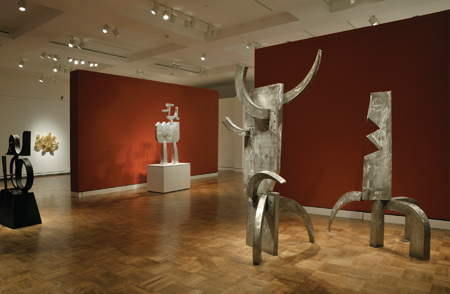
In the where-do-we-go-from-here moment experienced by many second generation, Left Coast Abstract Expressionists, Lee Kelly took to the streets. Or, more specifically, he took to the sidewalks, plazas, courtyards, and fields of the West as the most prolific maker of public artworks in what may prove to have been public art’s heyday. Kelly’s works grace sites from Seattle to Los Angeles to Houston, including the magnificent Cor-Ten steel Gate F (1972) at Candlestick Park in San Francisco and the massive slabs of the temple-like Leland I (1975), anchoring the series of Portland plazas designed by Lawrence Halprin. There was a time in the early ’70s, chief curator of the Portland Art Museum Bruce Guenther recalls, that Kelly was the only artist winning public art commissions on the West Coast.
A current retrospective at the museum traces the Oregon artist’s career while an accompanying book, “Lee Kelly,” includes lush photos of many of Kelly’s public art works as well as those in private collections like the bold, square knot of the Cor-Ten Tahoe (2006), Stainless Garden (1972), on the Stanford University campus, and those installed at Leland Iron Works, Kelly’s studio and home on a converted dairy farm not far from Portland. One of these is the monumental Memory 99 (1999), which manages to suggest both gargantuan calligraphy and archeological ruin in its grouping of forms in Cor-Ten steel.
A key moment in Kelly’s path from canvas to Cor-Ten and beyond that the exhibition captures is his leap from abstract expressionist painting to early sculptures that take gestural abstraction into three dimensions with bent and direct-welded sheet metal. The curved planes evoke the rounded shapes in his paintings, the rough welds, strokes of paint. The painted sculpture, Untitled (1961), is a meeting of these two directions. Kelly returns to consider surface in stainless works like Angkor I (1994), whose reflective surfaces, ground in sweeping gestures, are as important as its form. As well, the exhibition includes later wall-based sculptures and painted sculptures incorporating text fragments applied to the surfaces.
The exhibition is a fitting culmination for Kelly, who studied at the Museum Art School (now the Pacific Northwest College of Art or PNCA) in the late ’50s when it was still housed in the Portland Art Museum. The precocious Kelly caused a stir while still a student, when he began receiving large public commissions like that of creating four fountains for the Oregon Centennial Exposition thus presaging his 60+ year run as the Northwest’s most commissioned public artist. Just a few years out of school, Kelly had his first solo museum show at the museum in 1960, and his work was regularly curated into regional exhibitions there.
Kelly’s contributions to the cultural landscape have gone beyond great public sculptures. He was among the first board members of the seminal alternative arts space, the Portland Center for the Visual Arts, that from 1972 to 1987 brought important contemporary artists to Portland for exhibitions, installations, performances, and lectures. In the late ’70s he was appointed to the Portland Art Association’s Board of Trustees and Collections/Exhibition Committee. But perhaps his most poignant community-building effort is the Bonnie Bronson Fund he established in 1991 in memory of his second wife (with whom he collaborated for over 30 years) to provide support to artists committed to staying in the Pacific Northwest.
With Bronson, Kelly trekked and climbed throughout the Northwest and in the late ’70s went to Nepal and India for the first time. The trip was so inspiring to Kelly that he has become an inveterate traveler, visiting sites of temples and ruins in throughout Asia and the Americas. A 1985 Oregon Arts Commission fellowship supported his research into the traditional bronze casting methods of the Newari of Nepal.
Over the years, Kelly has garnered nearly every award offered to visual artists in the Northwest including the 1987 Governor’s Award for the Arts and the Master’s Fellowship in Sculpture from the State of Oregon in 1992. His work has been supported and honored by the NEA, the Ford Foundation, the Washington State Arts Commission, and many others.
When the current retrospective ends, Portland Art Museum visitors will continue to be greeted by Kelly’s Arlie (1978), permanently installed in the outdoor sculpture court. This most creature-like of his sculptures is a rounded body on three angular legs with a single circular “eye.” And the title? It’s Kelly’s given name. Standing before this outsized Arlie, one gets the feeling, as with many of Kelly’s Cor-Ten works, that somehow Arlie has always been there... and always will be.
—LISA RADON
“Lee Kelly,” at the Portland Art Museum, runs October 2, 1010 – January 9, 2011
www.portlandartmuseum.org
This article was written for and published in art ltd. magazine ![]()
